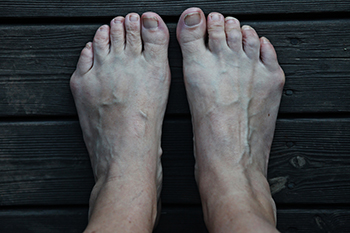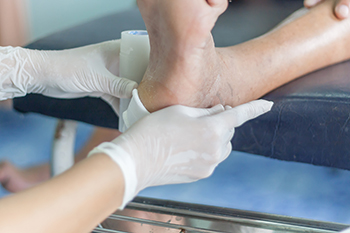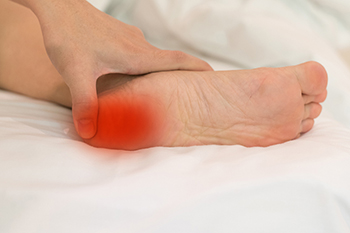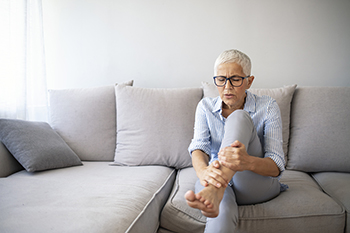Connect With Us
Blog
Items filtered by date: June 2022
What is a Bunionette?

A bunionette is a prominent deformity at the base of the fifth (or little) toe. It can be painful, particularly if it rubs against a tight-fitting shoe. This mini bunion occurs if the bone of the midfoot angles out and the little toe angles in, leading to a bony prominence. The toe might hurt on the outside or inside if that toe rubs against the fourth toe. Wearing wider shoes with space to accommodate the bump, wearing a toe spacer, or padding the bump will help prevent further irritation. Depending on the severity of the bump, it may be necessary to limit walking or standing. Surgery to remove the bunionette or reposition the baby toe are options when these do not work. If you have a bunionette, consult with a podiatrist who can take an X-ray to confirm the problem and provide treatment that is right for you.
If you are suffering from bunion pain, contact Dr. Nicholas Przystawski of Central Florida Foot Care, PA. Our doctor can provide the care you need to keep you pain-free and on your feet.
What Is a Bunion?
Bunions are painful bony bumps that usually develop on the inside of the foot at the joint of the big toe. As the deformity increases over time, it may become painful to walk and wear shoes. Women are more likely to exacerbate existing bunions since they often wear tight, narrow shoes that shift their toes together. Bunion pain can be relieved by wearing wider shoes with enough room for the toes.
Causes
- Genetics – some people inherit feet that are more prone to bunion development
- Inflammatory Conditions - rheumatoid arthritis and polio may cause bunion development
Symptoms
- Redness and inflammation
- Pain and tenderness
- Callus or corns on the bump
- Restricted motion in the big toe
In order to diagnose your bunion, your podiatrist may ask about your medical history, symptoms, and general health. Your doctor might also order an x-ray to take a closer look at your feet. Nonsurgical treatment options include orthotics, padding, icing, changes in footwear, and medication. If nonsurgical treatments don’t alleviate your bunion pain, surgery may be necessary.
If you have any questions, please feel free to contact our office located in Leesburg, FL . We offer the newest diagnostic and treatment technologies for all your foot care needs.
Symptoms of an Infected Foot Wound

It is beneficial to treat wounds on the feet as quickly as possible to avoid future health complications. Any cut or scrape on the bottom of the foot needs to be cleaned with an antiseptic, after the hands are thoroughly washed. This is followed by covering the cut with a dressing, and protecting it from getting wet. The cut will heal naturally, and eventually a scab will form. The foot may be wrapped by using tape to keep the bandage in place on the sole of the foot. Symptoms of an infected wound include redness surrounding the affected area, and it may begin to ooze a green or yellow fluid. Additionally, the wound may become painful, the entire foot may turn red, and swelling may increase. An infection on the foot may affect the entire body, and many people become lethargic. If you have a wound on your foot, it is strongly advised that you are under the care of a podiatrist who can properly treat this condition.
Wound care is an important part in dealing with diabetes. If you have diabetes and a foot wound or would like more information about wound care for diabetics, consult with Dr. Nicholas Przystawski from Central Florida Foot Care, PA. Our doctor will assess your condition and provide you with quality foot and ankle treatment.
What Is Wound Care?
Wound care is the practice of taking proper care of a wound. This can range from the smallest to the largest of wounds. While everyone can benefit from proper wound care, it is much more important for diabetics. Diabetics often suffer from poor blood circulation which causes wounds to heal much slower than they would in a non-diabetic.
What Is the Importance of Wound Care?
While it may not seem apparent with small ulcers on the foot, for diabetics, any size ulcer can become infected. Diabetics often also suffer from neuropathy, or nerve loss. This means they might not even feel when they have an ulcer on their foot. If the wound becomes severely infected, amputation may be necessary. Therefore, it is of the upmost importance to properly care for any and all foot wounds.
How to Care for Wounds
The best way to care for foot wounds is to prevent them. For diabetics, this means daily inspections of the feet for any signs of abnormalities or ulcers. It is also recommended to see a podiatrist several times a year for a foot inspection. If you do have an ulcer, run the wound under water to clear dirt from the wound; then apply antibiotic ointment to the wound and cover with a bandage. Bandages should be changed daily and keeping pressure off the wound is smart. It is advised to see a podiatrist, who can keep an eye on it.
If you have any questions, please feel free to contact our office located in Leesburg, FL . We offer the newest diagnostic and treatment technologies for all your foot care needs.
Arthritis Can Cause Pain in the Feet and Ankles
Different Forms of Heel Pain

Heel pain can be caused by a variety of factors, including biomechanical issues, injuries, arthritis, and more. By far, the most common form of heel pain is plantar fasciitis, a painful inflammation of the plantar fascia tissue on the bottom of the foot that connects the heel bone with the toes. Heel spurs, which often occur concurrently with plantar fasciitis, are actually bone growths that build up on the heel bone where the plantar fascia attaches to it as a result of long-term stress. Sever’s disease occurs in growing children. It is an inflammation in the growth plate of their heel that occurs from repetitive stress to the area from physical activity or overuse. Haglund’s deformity, also known as a pump bump, occurs when the bony section at the back of the heel rubs against shoes and causes the soft tissue to become irritated and form a bump where the heel attaches to the Achilles tendon. Nerve compression can also cause heel pain, numbness, and tingling. It is sometimes associated with an ankle sprain and is known as heel neuritis. There is a fluid-filled bursa sac at the back of the heel which can become irritated and swollen from improperly fitted footwear. This condition is known as bursitis. A podiatrist can diagnose your particular heel pain after reviewing your medical history, examining you, and running diagnostic tests. Call a podiatrist today to begin to get relief from your heel pain today.
Many people suffer from bouts of heel pain. For more information, contact Dr. Nicholas Przystawski of Central Florida Foot Care, PA. Our doctor can provide the care you need to keep you pain-free and on your feet.
Causes of Heel Pain
Heel pain is often associated with plantar fasciitis. The plantar fascia is a band of tissues that extends along the bottom of the foot. A rip or tear in this ligament can cause inflammation of the tissue.
Achilles tendonitis is another cause of heel pain. Inflammation of the Achilles tendon will cause pain from fractures and muscle tearing. Lack of flexibility is also another symptom.
Heel spurs are another cause of pain. When the tissues of the plantar fascia undergo a great deal of stress, it can lead to ligament separation from the heel bone, causing heel spurs.
Why Might Heel Pain Occur?
- Wearing ill-fitting shoes
- Wearing non-supportive shoes
- Weight change
- Excessive running
Treatments
Heel pain should be treated as soon as possible for immediate results. Keeping your feet in a stress-free environment will help. If you suffer from Achilles tendonitis or plantar fasciitis, applying ice will reduce the swelling. Stretching before an exercise like running will help the muscles. Using all these tips will help make heel pain a condition of the past.
If you have any questions please contact our office located in Leesburg, FL . We offer the newest diagnostic and treatment technologies for all your foot and ankle needs.
Osteoarthritis of the Big Toe

Osteoarthritis or OA is a common form of arthritis that can affect any joint in the body. This type of arthritis generally increases with age, and those who are obese, have a genetic predisposition to it, or a prior joint injury are at higher risk. Cartilage in joints wear down, bones are exposed, and they can rub against each other. The base of the big toe is a common site for OA. The joint degenerates and the body may attempt to repair the condition by growing more bone. This reaction can create bony protrusions called bone spurs that appear as a visible bump or callus on the big toe joint. The excess bone growth can lead to fusion of the joint and it can become fixed/non-bending. The joint of the big toe may also look inflamed and swollen. It becomes painful and hard to walk if one cannot bend their toe, and if spurs or bunions develop, they can push uncomfortably against shoes. Usually, OA in the big toe is worse after inactivity, such as when first arising in the morning or after prolonged sitting. Wearing shoes that have sufficient room in the toe box and stiff soles, obtaining pad inserts or arch supports, using ice on the big toe, maintaining a healthy body weight, and/or taking over-the-counter pain relievers can help but there is no cure for OA. If you are suffering with big toe pain, consult with a podiatrist who can properly diagnose the condition and recommend a treatment plan to help you live more comfortably.
Arthritis can be a difficult condition to live with. If you are seeking treatment, contact Dr. Nicholas Przystawski from Central Florida Foot Care, PA. Our doctor can provide the care you need to keep you pain-free and on your feet.
Arthritic Foot Care
Arthritis is a term that is commonly used to describe joint pain. The condition itself can occur to anyone of any age, race, or gender, and there are over 100 types of it. Nevertheless, arthritis is more commonly found in women compared to men, and it is also more prevalent in those who are overweight. The causes of arthritis vary depending on which type of arthritis you have. Osteoarthritis for example, is often caused by injury, while rheumatoid arthritis is caused by a misdirected immune system.
Symptoms
- Swelling
- Pain
- Stiffness
- Decreased Range of Motion
Arthritic symptoms range in severity, and they may come and go. Some symptoms stay the same for several years but could potentially get worse with time. Severe cases of arthritis can prevent its sufferers from performing daily activities and make walking difficult.
Risk Factors
- Occupation – Occupations requiring repetitive knee movements have been linked to osteoarthritis
- Obesity – Excess weight can contribute to osteoarthritis development
- Infection – Microbial agents can infect the joints and trigger arthritis
- Joint Injuries – Damage to joints may lead to osteoarthritis
- Age – Risk increases with age
- Gender –Most types are more common in women
- Genetics – Arthritis can be hereditary
If you suspect your arthritis is affecting your feet, it is crucial that you see a podiatrist immediately. Your doctor will be able to address your specific case and help you decide which treatment method is best for you.
If you have any questions, please feel free to contact our office located in Leesburg, FL . We offer the newest diagnostic and treatment technologies for all your foot care needs.

